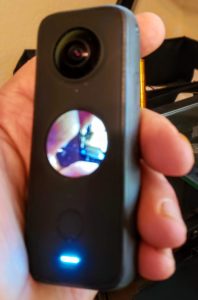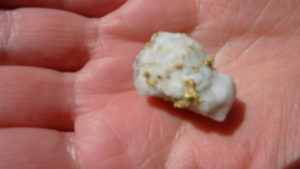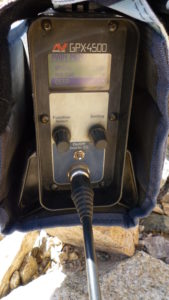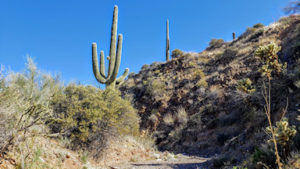Arizona Gold Prospecting Hunting
San Domingo placers . . . 45 MI NORTHWEST OF PHOENIX, 7 MI SOUTHEAST OF WICKENBURG, 3 MI NORTHWEST OF MORRISTOWN AZ.
If you like the outdoors and can appreciate the history and legacy of gold mining, weekend gold prospecting may be your ideal hobby.
Arizona Gold Prospecting Hunting

Insta360 One X2

Insta360 One X2 camera
Direct link to Insta360 One X2 manufacturer’s site w/bonus!
Insta360 One X2

I don’t want to bust your bubble, but if you’re thinking of getting into gold prospecting to make some extra cash, you’d work a lot less strenuously and make a lot more money per hour if you got a job at Walmart!
Really, what gold prospecting amounts to now, in the United States, is cleaning up the crumbs from the old-time miners! And, if you think the easy way to find gold is with a metal detector in the desert, I’m also afraid that you’re in for a rude awakening. There is practically no place you can go, that doesn’t have a lot of metal trash, lead bullet heads, shotgun steel BBs and rusted out tin cans or barbed wire. All these, gives similar indications on metal detectors, and you’ll have to spend the time to dig up each one. Depending on the area you’re in, the ratio of finding small gold nuggets to digging up trash could be many dozens to one!

Arizona gold in quartz
With the latest high-tech gold metal detectors going for over $7,000, I seriously believe that only of small fraction of 1% of these detector buyers will ever come close to making back the cost of their detector!

Minelab gold metal detector
I’m not being negative here, I’m just trying to be truthful. I would equate the chances of making back the cost of whatever gold metal detector you purchase, to the similar odds of hitting a major slot machine jackpot in Vegas! But, with that said, if you’re looking to get off the couch, get some good exercise and enjoy the outdoors while learning about geology and mineralogy, this is one great hobby!

From Wikipedia, the free encyclopedia:
Arizona has produced more than 16 million troy ounces (498 tonnes) of gold.
Gold mining in Arizona reportedly began in 1774 when Spanish priest Manuel Lopez directed Papago Indians to wash gold from gravel on the flanks of the Quijotoa Mountains, Pima County. Gold mining continued there until 1849, when the Mexican miners were lured away by the California Gold Rush. Other gold mining under Spanish and Mexican rule took place in the Oro Blanco district of Santa Cruz County, and the Arivaca district, Pima County.
Mountain man Pauline Weaver discovered placer gold on the east side of the Colorado River in 1862. Weaver’s discovery started the Colorado River Gold Rush to the now ghost town of La Paz, Arizona and other locations along the river in the ensuing years.
The most prominent of these were those of the San Francisco district, which includes the towns of Oatman, Bullhead City and Katherine in Mohave County was discovered in 1863 or 1864, but saw little activity until a rush to the district occurred in 1902. The district produced 2.0 million ounces of gold through 1959.
The gold-bearing quartz veins of the Vulture Mine, southwest of Wickenburg, in Maricopa County were discovered in 1863. The mine produced 366,000 troy ounces (11,400 kg) of gold through 1959.
The last gold mine to operate in Arizona was the Gold Road mine at Oatman, which shut down in 1998. Patriot Gold is exploration drilling at the Moss mine at Oatman.
In 2006, all of Arizona’s gold production came as a byproduct of copper mining.
Gold is resistant to most acids, though it does dissolve in aqua regia (a mixture of nitric acid and hydrochloric acid), which forms a soluble tetrachloroaurate anion. Gold is insoluble in nitric acid, which dissolves silver and base metals, a property that has long been used to refine gold and to confirm the presence of gold in metallic substances, giving rise to the term acid test. Gold also dissolves in alkaline solutions of cyanide, which are used in mining and electroplating. Gold dissolves in mercury, forming amalgam alloys, and as the gold acts simply as a solute this is not a chemical reaction.
A relatively rare element, gold is a precious metal that has been used for coinage, jewelry, and other arts throughout recorded history. In the past, a gold standard was often implemented as a monetary policy, but gold coins ceased to be minted as a circulating currency in the 1930s, and the world gold standard was abandoned for a fiat currency system after 1971.
A total of 197,576 tonnes of gold exists above ground, as of 2019. This is equal to a cube with each side measuring roughly 21.7 meters (71 ft). The world consumption of new gold produced is about 50% in jewelry, 40% in investments, and 10% in industry. Gold’s high malleability, ductility, resistance to corrosion and most other chemical reactions, and conductivity of electricity have led to its continued use in corrosion resistant electrical connectors in all types of computerized devices (its chief industrial use). Gold is also used in infrared shielding, colored-glass production, gold leafing, and tooth restoration. Certain gold salts are still used as anti-inflammatories in medicine. As of 2017, the world’s largest gold producer by far was China with 440 tonnes per year.
+++++++
Be sure to view our Gold nuggets for sale.
View our Natural Silver specimens
Also see the most expensive type of gold nuggets, the Crystalline Gold Nuggets
Subscribe to our Youtube Arizona Gold Prospecting channel
0 Comments